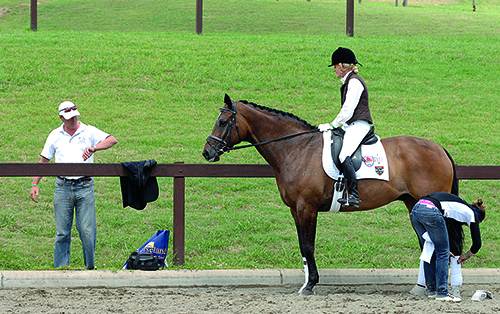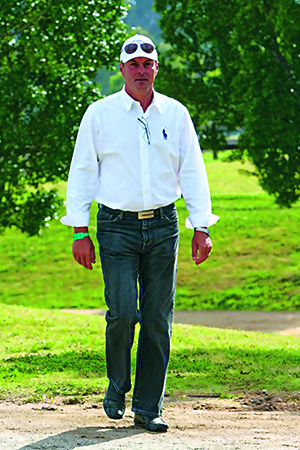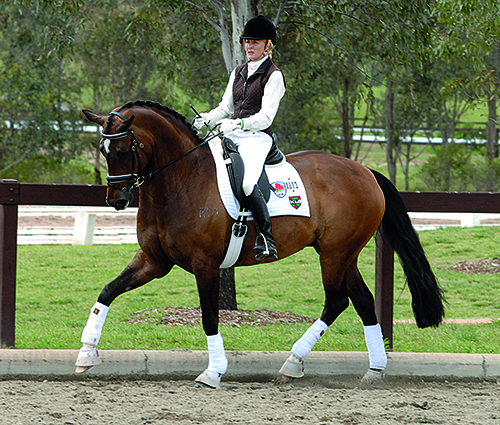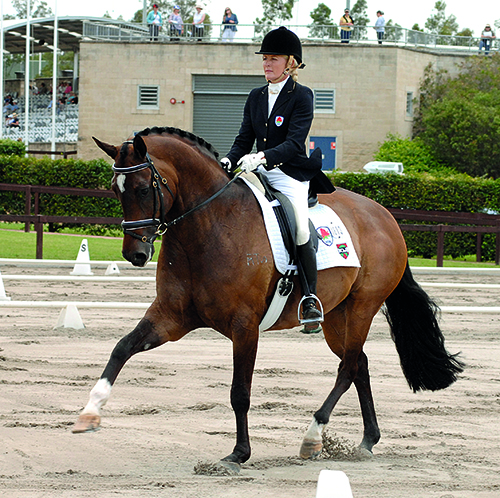Story by Shannan Makauskas & Photos by Alex Makauskas
It’s not often you get the chance to question a coach on their warm up tactics, especially at a National Championship where the pressure is on and the stakes are high. But last year, Pferdewirtschaftsmeister Carlos De Cleermaecker, was hovering around the arena as Queensland State Dressage coach and I was given just that – the opportunity to see the trainer prepare his long-term pupil and wife, Melinda Morris.
Riding her nine-year-old Weltmeyer gelding, Schyborne, Melinda was getting ready for her second test for the day. Carlos took this into consideration with their warm up: “It’s very important to get him over the back because they’ve been spending a long time in the stables and he did a hard job before. So it’s good to walk him for a while, make all the muscles supple.”
Although Carlos has lived in Australia for seven years he hasn’t lost his charming European accent. A factor, which, I think, has considerable influence on keeping his riders relaxed at competition. When I listened to him instruct Melinda this certainly came into play:
“It’s always easier when you see this person a little more before. You don’t like to change too much. Good, that’s a good angle. That was a leg yield and can you see now there is more cadence in his trot? Very good trot darling, that’s the trot yeah?”
Carlos likes to add ‘darling’ onto his wife’s instructions and yes it’s a regular thing. But what about when he’s giving some constructive criticism? “Especially then,” he laughs. “Sometimes at home I sit on the horse and show how it can be. But it’s very important to keep them both happy in the warm up and to have the combination going to the test really happy, in the right frame.”
I notice some subtle differences between how Carlos approaches the warm up at a competition to a warm up at home. Firstly, the arena at home is for training. Whereas the competition warm up arena is for making the best of what you’ve got when you get there. Carlos said: “You can’t fix everything on competition day.”
Therefore Carlos focuses on areas he can improve: “You can make some things happen like rhythm, the position of the horse and the rider. I just tell the rider what the right rhythm and tempo is, when they’re in the right frame. At home some of the riders have the mirrors so at a competition I need to be their eyes on the ground to help.”
For Carlos it comes down to knowing the combination: “The important thing is to know some can have more pressure and other ones you have to be careful with. To teach your wife is a tricky thing, still I must be correct and honest.”
When it comes to Schyborne and Melinda, Carlos has had plenty of time to formulate a strategy: “We work a lot on suppleness. We have a beautiful walk and a beautiful canter, we did a lot on his trot work. He’s not one of those naturally balanced horses who trot immediately for a ten. But you can make the trot really nice when the horse is supple and he starts to use his three joints more – the hips, the stifle and the hocks. Then they get more bend, more elasticity, more spring. Then we also work on transitions to get him through.”
Several minutes into the trot work I noticed Melinda doing a familiar exercise – trotting down the quarter line, riding two steps of leg yield, then riding straight again. Carlos said: “We do this to activate and to make the horse work behind more. We also want to know we have control of the legs, he is responsive to the aids.”
“For Schyborne we do a lot of trot canter transitions. It gets him really nicely over the back and then the trot comes stronger.” He praised Melinda: “Good, always trying to bring his hind legs into the point of gravity.”
I posed a few questions to Carlos while we watched Melinda from the sideline. Do you keep the warm up for the second test shorter than the first? “It depends on the rider. She knows her horse very well but at times we give them a break. When we think it could be too much, we do a walk break and walk the horse with longer reins, relax him. But it’s better to sit early enough on the horse so if he needs more time you can give it to him. Otherwise the rider ends up pulling him together, not very good.”
The approach is different for the more sluggish: “If you have a lazy horse you don’t make him too tired. You just get on and see how supple they are. You don’t ask for too much trot work and canter work in the warm up. You just keep them sharp on your leg, make him supple and try to get all your exercises through in the training so you just need a little warm up. Just keep him sharp. In low levels you have your whip, but when you come to Prix St Georges at CDI and nationals you can’t use it and there’s no back-up plan.”
I remember back to my very first lesson with Carlos where he suggested I ride with a whip because, ‘All good soldiers must come prepared to the battlefield’. He said: “The horse knows if the rider has the whip or not. What you have to do is train at home without the whip sometimes and get him sharp and to really respect your leg. You can’t teach him to listen to your leg if you always have a whip. But at times what we do is we don’t use our whip when we need it. Really you just have to take it for five minutes. You use it for the exercise and try again without it, and you play with that. But you have to really feel comfortable to have something in your hands.”
Carlos advised on dealing with horses that become ‘test smart’: “Sometimes they go lazy in the test and the horse knows you won’t kick him or make a fuss. But at times you should give him a kick in little competitions and say, ‘That’s not going to work like that my friend’, and you just don’t care about the marks. But it needs to be under control, not that it starts to be a regular thing.”
In the meantime Melinda has dropped her whip and Carlos exclaimed: “Oops she lose her bazooka! Bad soldier.”
Which type of horse is Schyborne, lazy or hot? “He’s a good worker. He works always with the rider, he will never do something wrong, but still you have to ask the right things. It looks easy with him because we have been working together for years. Still some days you have a bad day, but when you’re at a competition, working-in for a test, you can’t change too much. You have to take the important things and try to make these better. I look at the combination and ask what could give them more marks in the test? That’s what’s important.”
Do you do a lot of test riding at home? “Not much but we do parts from the test, not always the test. We work more on the basics – transitions, making every pace better, working on the trot, the canter, the collection.”
“The week before a competition we work on the exercises that we have to do in the test. We give him a lot of time, a lot of suppleness exercises, leg yields, transitions, working on the straightness.”
Carlos is often away from home in New South Wales helping the enemy, the Queensland riders. But Melinda is more than capable of formulating her own strategies: “When I get time I’ll break his training up into two sessions a day, quick sessions rather than long ones because he doesn’t like the heat too much. He works better with the two and that’s how it is when you’re at a competition.”
“I like to give him a good 20 minute walk and put him out in the paddock. We don’t just stay in the arena either. I do dressage everyday but I like to vary it with a bit of cavaletti work, trot poles, gymnastic work. Other days I’ll take him out in the paddock and do some forward seat canter and then do more collection in the afternoon in the arena.”
In Melinda’s first test – which was not surprisingly a lovely test, with smooth transitions in that round, soft frame Schyborne has mastered so well – their only mistake was a very slightly crooked extended canter. Is this something Carlos will work on before the next test? “Of course I try to remind the rider to always keep the horse straight, but sometimes you have a lot to think about. It was a shame because he has a very good canter, uphill, an amazing canter. But it was only a slight problem.”
The canter is certainly his strength but what’s more is his temperament: “He’s always been really on the job and he still needs to give his first buck. He never bucked while being broken in and still hasn’t. He can be stupid in the paddock but when you put a saddle on him, he’s very behaved.”
Melinda said: “He has a very good temperament but he’s a sensitive horse which is a rare combination and it makes him quite trainable. We’ve taken it really slow, he had seven months out with colic surgery but he’ll be ready to go into the double next year and probably have more collection and real engagement but it will be true because we’ve hopefully done it correctly and in a snaffle.”
Schyborne is quiet yet he is active, a consequence of their work at home. Carlos said: “From when he was young he always had a very good walk and very good canter and the trot is the pace that you can improve the most. He does a great job now. But we always ride at home active, light to the aids, this is what we’re training so when we come to the competition, he does this automatically.”
How do you achieve that? “Of course we work on the basics, repeating exercises. The more you have them true in the contact, the better the exercises work. Next year we would like him working and competing in the Prix St Georges but because he’s now established in the basics it will come quickly. It will be easy to get him to the next level.”
How would you approach the warm-up if he were a hotter, sensitive horse? “You work more on the suppleness and the relaxation. With that type of horse we put them deeper. But we give them a lot more time to get there. Whereas the other ones they don’t need that long, they just need to be really in the front of your aids. So it’s always different.”
There are myriad ways of approaching work with a spooky horse and Carlos has his own take on the situation: “I try to work him through to the contact on the spots of the warm up arena where he’s not spooky, and when he’s more loose and supple and not so tense and fresh and more on the job, I will go to the spots he is spooky. Then I have more tools to use to help him get over it.”
Do you think a horse that’s completely’ through’ doesn’t get frights? “I taught a girl whose horse would need three days to get past a chair. Then you put the chair one metre the other way and he needed another three days to get past it. So I started riding the horse and he was not properly through, he was not absolutely into the contact. I put him in a really low frame, and deep, and just rode him and have more throughness. Then I come to the chair and I would be gentle, give him more confidence. Now, I have to say, he will go past any chair.”
How would you approach a tense horse’s first competition? “I would ride them more times. I mean the first time when you go with a horse to a competition it’s a big experience both for the rider and the horse because you don’t know exactly what the horse will do. If I had a tense horse that was nervous and the test was at lunchtime I would ride it for quite a long time. Give him a lot of relaxation in the morning at seven or eight o’clock, show him everything and still give him another ride an hour before the test when he’s relaxed.”
“I’d walk more but not make him tired. That’s the most difficult part of warming up, the timing, not too long, not too short. Because you can build something up and then they peak, and you will never find that moment again. But that’s all experience.”
Carlos looked across and observed Melinda’s transitions between collected and extended trot: “Good trot, good keeping the rhythm. You see there the shoulder in was nice, he was keeping his rhythm from his collected trot and into his lengthened strides, which is very important.”
A lot of horses get in the test and lose the rhythm in the lateral work… “They need to have the strength to maintain it. We try to keep the inside hind leg active. When you lose it, we go out, ride them straight, get the rhythm back. Bring them back a couple of steps in lateral work, take them forward and try to have him really there. Keeping him active behind so he can keep his rhythm and carry himself. Rhythm is very important, getting the right tempo, you can get it in the warm up but they can’t always keep it in the test.”
When it comes to riding the test and these things start to slip away, there are often sacrifices we make. Carlos believes in prioritising the quality of the work, over the accuracy of the test: “You have to try and do everything on the letter, but at times when he’s really not right in the contact I wait longer to get the horse into the contact. Then perhaps I’m two metres too late and it’s not directly on the letter.”
“If you have to choose I think it’s better to show the judges a better transition where the horse is prepared, than to show something on the letter that doesn’t work. Then you have a lot of resistance and it makes the mark no better. So if you were to score an eight because what you were doing is good, but it’s not on the letter they can still give you a seven. When you do something on the letter and it’s really worse, you get a five or a four, so the marks are no better.”
But ultimately: “You should teach your horse to do it on the letter. The more transitions you are doing at home, practicing making the transitions on the letter to teach your horse to do it on the aid, the better you know exactly where you have to start your preparation to have it done on the letter. It’s all training at home. It’s all preparation.”
Establishing the basics is the best way to ensure success: “You need to have your horse into the contact, it’s the only way you can do anything. Then you can bring him back, ride him forward and ride the movements, whatever you want. But the contact must still be there steady. We need a steady contact to prepare things.”
Making the horse easily adjustable is the ultimate goal: “When the rider has control of the frame and can keep the hind legs active, keep the back swinging, you’re a good rider because you can fix a lot of problems. It’s easy to teach people who control their horse 100% because they just do it, they can adjust the horse. Like if you have a problem in a pirouette and you say, ‘He’s too much up take him lower,’ if the rider is able to take the horse immediately into a lower frame and repeat this canter pirouette, then you get immediately a good result.”
Watching Carlos work with Melinda I can see this is definitely the case – she is able to adjust the pace, change the head-carriage and move in or out of a lateral exercise as swiftly as the comings-and-goings of the wind. Besides this, Melinda is quiet in the saddle and elegant, a characteristic I’m sure she would be credited for even without the years of training with Carlos. They went into the test and alas, it was mistake-free for 4th place in the Medium. Their secret to success? A tactful warm-up of course!





